RBSE Solutions for Class 12 Maths Chapter 9 Differential Equations Ex 9.6
Rajasthan Board RBSE Solutions for Class 12 Maths Chapter 9 Differential Equations Ex 9.6 Textbook Exercise Questions and Answers.
RBSE Class 12 Maths Solutions Chapter 9 Differential Equations Ex 9.6
Question 1.
\(\frac{d y}{d x}\) + 2y = sin x
Answer:
Given differential equation is
\(\frac{d y}{d x}\) + 2y = sin x ........... (1)
Comparing equation (1) with \(\frac{d y}{d x}\) + Py = Q
P = 2, Q = sin x
∴ I.F. = e∫2 dx = e2x
Multiplying equation (1) by e2x, we get
e2x \(\frac{d y}{d x}\) + 2e2x y = e2x sin x
or \(\frac{d}{d x}\) (ye2x) = e2x sin x
Integrating both sides w.r.t. “x”, we get
ye2x = ∫e2x sin x dx ...... (2)
Let I = ∫e2x sin x dx
= e2x ∫sin x dx - ∫{\(\frac{d}{d x}\) e2x ∫ sin x dx} dx
[Integrating by parts taking e2x as first function]
= e2x (- cos x) - ∫2e2x (- cos x) dx
= - cos x e2x + 2 ∫e2x cos x dx + C1
= cos x e2x + 2 [e2x ∫ cos x - ∫{\(\frac{d}{d x}\) (e2x) ∫cos x dx } dx] + C1
or I = - e2x cos x + 2[e2x sin x - ∫2e2x sin x dx] + C1
= - e2x cos x + 2e2x sin x - 4∫e2x sin x dx + C1
= - e2x cos x + 2e2x sin x - 4I + C1
or I + 4I = - e2x cos x + 2e2x sin x + C1
or 5I = - e2x cos x + 2e2x sin x + C1
or I = \(\frac{1}{5}\) [- e2x cos x + 2e2x sin x] + \(\frac{1}{5}\)C1
Putting the value of I in equation (2), we get
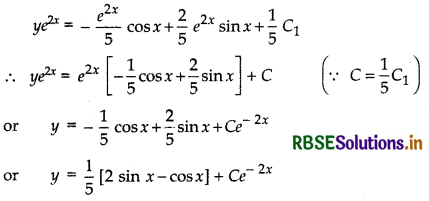
which is the required solution.

Question 2.
\(\frac{d y}{d x}\) + 3y = e-2x
Answer:
Given differential equation is
\(\frac{d y}{d x}\) + 3y = e-2x
Comparing equation (1) with \(\frac{d y}{d x}\) + Py = Q
P = 3, Q = e- 2x
∴ I.F. = e∫3 dx = e3x
Multiplying equation (1) by e3x, we get
e3x \(\frac{d y}{d x}\) + 3e3xy = e-2x × e3x
or \(\frac{d}{d x}\)(ye3x) = ex
integrating both sides w.r.t. “x”, we get
ye3x = ∫ex dx + C
or ye3x = ex + C
or y = ex × e-3x + Ce-3x
or y = e-2x + Ce-3x
which is the required solution.
Question 3.
\(\frac{d y}{d x}+\frac{y}{x}\) = x2
Answer:
Given differential equation is
\(\frac{d y}{d x}+\frac{y}{x} \) = x2 ............ (1)
Comparing equation (1) with \(\frac{d y}{d x}\) + Py = Q
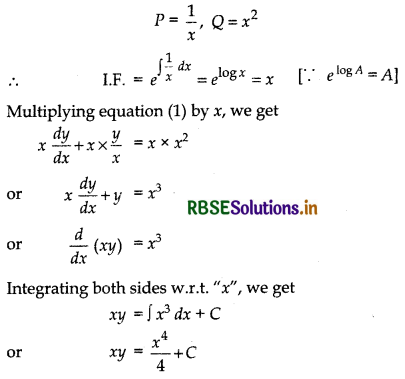
which is the required solution.

Question 4.
\(\frac{d y}{d x}\) + (sec x)y = tan x (0 ≤ x < \(\frac{\pi}{2}\))
Answer:
Given differential equation is
\(\frac{d y}{d x}\) + (sec x)y = tan x
Comparing equation (1) with \(\frac{d y}{d x}\) + Py = Q
P = sec x, Q = tan x
∴ I.F. = e∫ sec x dx = elog(sec x + tan x)
= sec x + tan x
Multiplying equation (1) by (sec x + tan x), we get
(sec x + tan x) \(\frac{d y}{d x}\) + (sec x + tan x) (sec x)y = (sec x + tan x) tan x
or (sec x + tan x)\(\frac{d y}{d x}\) + (sec2 x + sec x tan x)y = sec x tan x + tan2 x
or \(\frac{d y}{d x}\) {(sec x + tan x)y} = sec x tan x + (sec2x - 1)
Integrating both sides w.r.t. “x”, we get
y(sec x + tan x) = ∫sec x tan x dx + ∫ sec2 x dx - ∫dx + C
or y(sec x + tan x) = sec x + tan x - x + C
which is required solution.
Question 5.
cos2 x \(\frac{d y}{d x}\) + y = tan x (0 ≤ x < \(\frac{\pi}{2}\))
Answer:
Given differential equation is
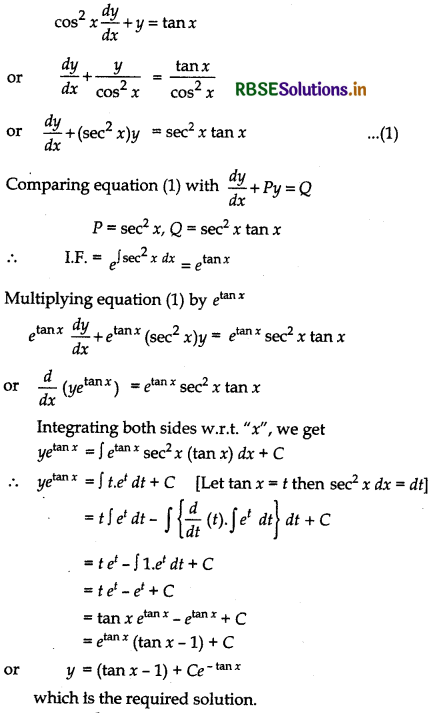
Question 6.
x \(\frac{d y}{d x}\) + 2y = x2 log x
Answer:
Given differential equation is
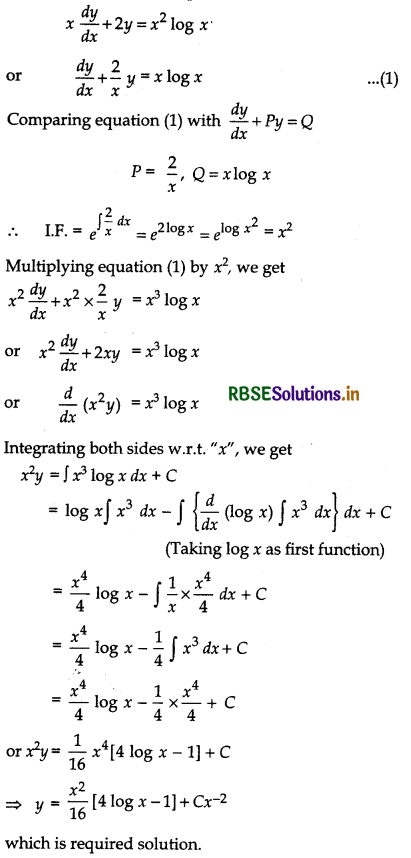

Question 7.
x log x \(\frac{d y}{d x}\) + y = \(\frac{2}{x}\) log x
Answer:
Given differential equation is
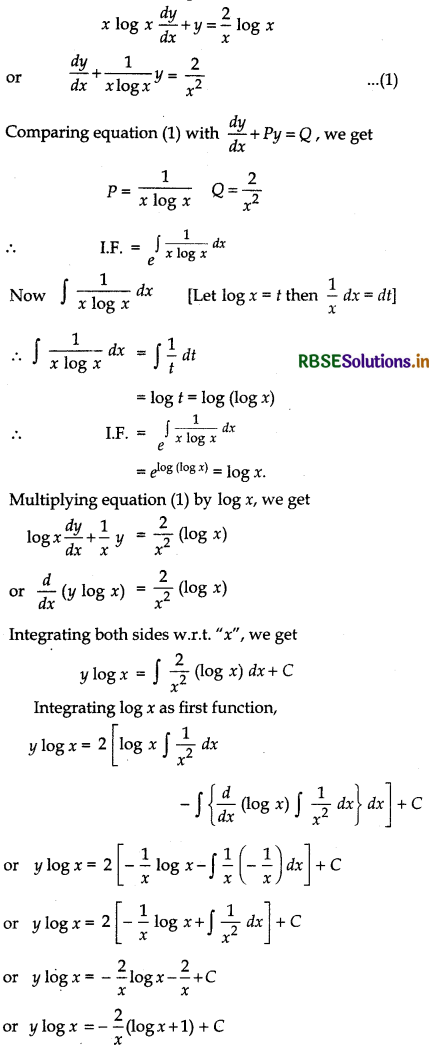
which is required solution.
Question 8.
(1 + x2) dy + 2xy dx = cot dx (x ≠ 0)
Answer:
Given differential equation is
(1 + x2) dy + 2xy dx = cot x dx
Dividing equation (1) by (1 + x2) dx, we get
or \(\frac{d y}{d x}+\frac{2 x}{1+x^2}\) y = \(\frac{\cot x}{1+x^2}\) ....... (1)
Comparing equation (1) with \(\frac{d y}{d x}\) + Py = Q, we get
P = \(\frac{2 x}{1+x^2}\), Q = \(\frac{\cot x}{1+x^2}\)
∴ I.F. = \(e^{\int \frac{2 x}{1+x^2}}\) dx = elog (1 + x2) = (1 + x2)
Multiplying equation (1) by (1 + x2), we get
(1 + x2)\(\frac{d y}{d x}\) + 2xy = cot x
or \(\frac{d}{d x}\)[y(1 + x2)] = cot x
Integrating both sides w.r.t. “x”, we get
y(1 + x2) = ∫ cot x dx + C.
or y(1 + x2) = log |sin x| + C
or y = (1 + x2)-1 log |sin x| + C(1 + x2)-1
which is required solution.
Question 9.
x\(\frac{d y}{d x} \)+ y - x + xy cot x = 0, (x ≠ 0).
Answer:
Given differential equation is
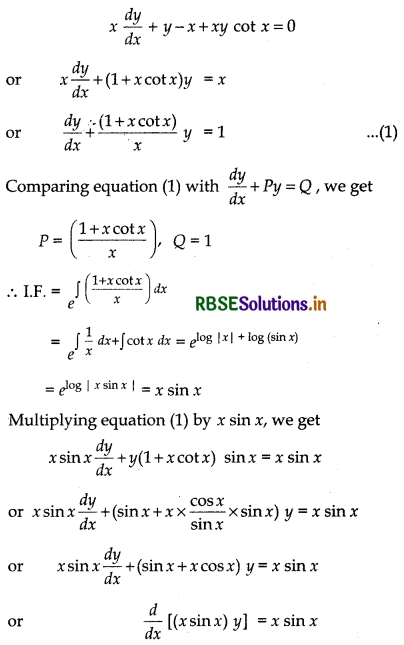
Integrating both sides w.r.t. "x", we get
xy sin x = ∫ x sin x dx + C
(Taking x as first function)
= x ∫sin x dx - ∫ {\(\frac{d}{d x}\) (x) ∫ sin x dx } dx + C
= x (- cos x) - ∫1 (- cos x) dx + C
= - x cos x + ∫ cos x dx + C
= - x cos x + sin x + C
or xy sin x = - x cos x + sin x + C
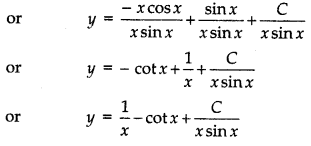
which is required solution.

Question 10.
(x + y)\(\frac{d y}{d x}\) = 1
Answer:
Given differential equation is
(x + y)\(\frac{d y}{d x}\) = 1
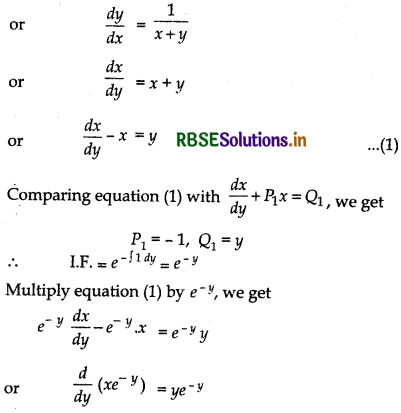
Integrating both sides w.r.t. "y", we get
xe-y = ∫ye-y dy + C
= - y(e-y - ∫{\(\frac{d}{d y}\) (y) ∫e-y dy } dy + C
(Integrating by parts taking y as a first function.)
= - ye-y - ∫1.(- e-y) dy + C
= - ye-y + ∫e-y dy + C
= - ye-y - e-y + C
xe-y = - ye-y - e-y + C
or xe-y = - e-y (y + 1) + C
or x = - (y + 1) + CeY
or x + y + 1 = CeY
which is the required solution.
Question 11.
y dx + (x - y2)dy = 0
Answer:
Given differential equation is
y dx + (x - y2)dy = 0
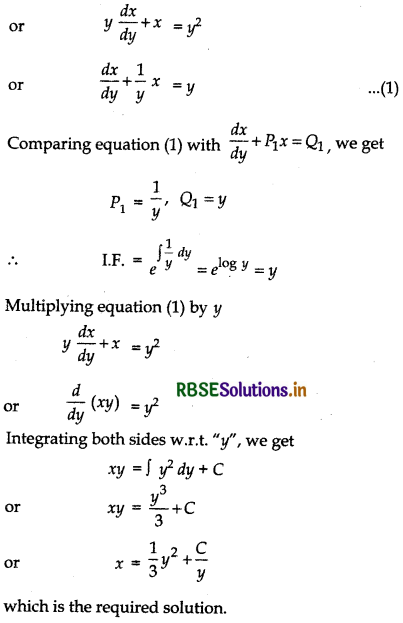
Question 12.
(x + 3y2)\(\frac{d y}{d x}\) = y (x > 0)
Answer:
Given differential equation is
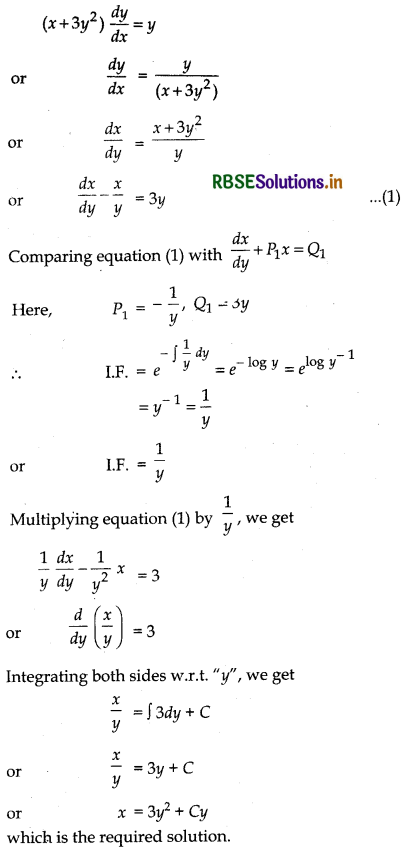
Question 13
\(\frac{d y}{d x}\) + 2y tan x = sin x; y = 0 when x = \(\frac{\pi}{3}\).
Answer:
Given differential equation is
\(\frac{d y}{d x}\) + (2 tan x)y = sin x
Comparing equation (1) with \(\frac{d y}{d x}\) +Py = Q, we get
P = 2 tan x, Q = sin x
∴ I.F. = e∫2 tan x dx = e2∫tan x dx
= e2 log sec x = elog (sec2 x)
or I.F. = sec2 x
Multiplying equation (1) by sec2 x
sec2 x \(\frac{d y}{d x}\) + (2 sec2 x tan x)y
= sec2 x sin x = \(\frac{\sin x}{\cos ^2 x}\)
or \(\frac{d}{d x}\) (y sec2 x) = sec x tan x
Integrating both sides w.r.t. “x”, we get
y sec2 x = ∫ sec x tan x dx + C
or y sec2 x = sec x + C ...... (2)
Putting x = \(\frac{\pi}{3}\) and y = 0 in equation (2), we get
0 × sec2 \(\frac{\pi}{3}\) = sec \(\frac{\pi}{3}\) + C
or 0 = 2 + C
∴ C = - 2
Putting the value of C in equation (2), we get
y sec2 x = sec x - 2
or y = \(\frac{\sec x}{\sec ^2 x}-\frac{2}{\sec ^2 x}\)
or y = cos x - 2 cos2 x
which is the particular solution.

Question 14.
(1 + x2) \(\frac{d y}{d x}\) + 2xy = \(\frac{1}{1+x^2}\); y = 0 when x = 1
Answer:
Given differential equation is
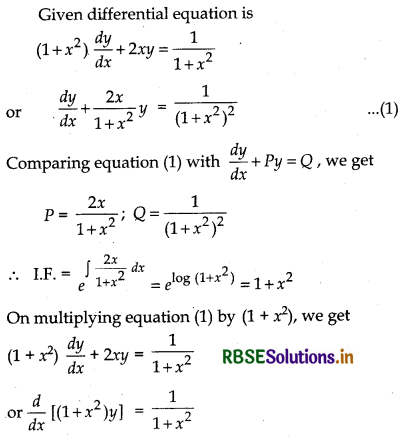
Integrating both sides w.r.t. "x", we get
y(1 + x2) = ∫\(\frac{1}{1+x^2}\) dx + C
or y(1 + x)2 = tan-1 x + C ........ (2)
Putting x = 1 and y O in equation (2), we get
0(1 + 1)2 = tan-1 1 + C
or 0 = \(\frac{\pi}{4}\) + C
or C = - \(\frac{\pi}{4}\)
Putting the value of C in equation (2), we get
y(1 + x2) = tan-1 x -\(\frac{\pi}{4}\)
which is the required solution.
Question 15.
\(\frac{d y}{d x}\) - 3y cot x = sin 2x; y = 2 when x = \(\frac{\pi}{2}\).
Answer:
Given differential equation is
\(\frac{d y}{d x}\) - 3y cot x = sin 2x
or \(\frac{d y}{d x}\) - (3 cot x)y = sin 2x ............. (1)
Comparing equation (1) with \(\frac{d y}{d x}\) + Phy = Q, we get
P = - 3 cot x, Q = sin 2x
∴ I.F. = e- ∫ 3 cot x dx = e - 3 log |sin x|
= elog (sin x)-3 = (sin x)- 3 = cosec3 x
or I.F. = cosec3 x
On multiplying equation (1) by cosec3 x, we get
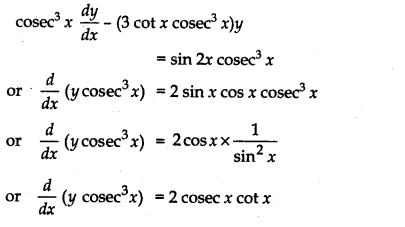
Integrating both sides w.r.t. “x”, we get
y cosec3 x = 2∫cosec x cot x dx + C
or y cosec3 x = - 2 cosec x + C
Putting x = \(\frac{\pi}{2}\) and y = 2 in equation (2), we get
2 × cosec2 \(\frac{\pi}{2}\) = - 2 cosec \(\frac{\pi}{2}\) + C
2 × 1 = - 2 × 1 + C
or 2 = - 2 + C
or C = 4
Putting the value of C in equation (2)
y cosec3 x = - 2 cosec x + 4
or y = 4 sin3 x - 2 sin2x
or y = - 2 sin2 x(1 - 2 sin x)
which is the required solution.

Question 16.
Find the equation of a curve passing through the origin given that the slope of the tangent to the curve at any point (x, y) is equal to the sum of the co-ordinate of the point.
Answer:
Slope of the tangent at point(x, y) of the curve is \(\frac{d y}{d x}\).
∴ Given \(\frac{d y}{d x}\) = x + y
or \(\frac{d y}{d x}\) - y = x
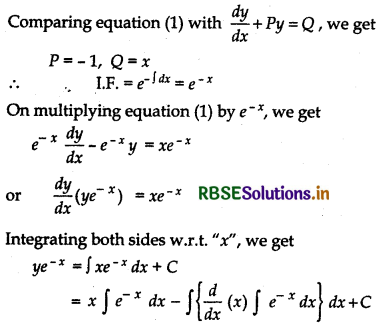
(Integrating by parts taking x as the first function)
= x(- e-x) - ∫1.(- e-x)dx + C
= - xe-x + ∫e-x dx + C
or ye-x = - xe-x - e-x + C
or ye-x = - e-x (x + 1) + C ........ (2)
∵ Curve passes through origin (0, 0), so, putting x = 0,
y = 0 in equation (2), we get
0 × e-0 = - e-0 (0 + 1) + C
or 0 = - 1 (1) + C
or C = 1
Puffing the value of C in equation (2), we get
ye-x = - e-x(x + 1) + 1
or y = - (x + 1) + ex
or y + x + 1 = ex
or x + y + 1 = ex
which is the required equation of the curve.
Question 17.
Find the equation of a curve passing through the point (0, 2) given that the sum of the co-ordinates of any point on the curve exceeds the magnitude of the slope of the tangent to the curve at that point by 5.
Answer:
Slope of the tangent at point (x, y) of the given curve is \(\frac{d y}{d x}\).
Given, x + y = \(\left|\frac{d y}{d x}\right|\) + 5
or \(\left|\frac{d y}{d x}\right|\) = x + y - 5
or \(\frac{d y}{d x}\) = ± (x + y - 5)
(i) Taking + ve sign,
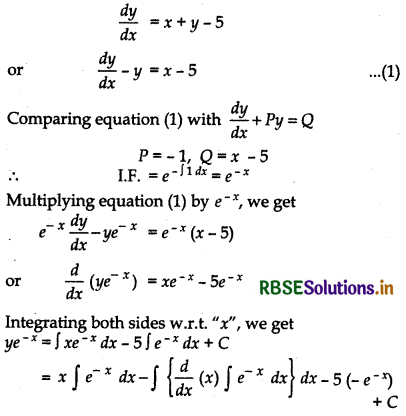
= x(- e-x) - ∫1 (- e-x)dx + 5e-x + C
= - xe-x + ∫e-x dx + 5e-x + C
= - xe-x - e-x + 5e-x + C
or ye-x = - e-x (x - 4) + C
or y = - (x - 4) + Cex
or x + y - 4 = CeX ..... (3)
Putting x = 0 and y = 2 in equation (3), we get
0 + 2 - 4 = Ce0
or - 2 = C
C = - 2
Putting the value of C in equation (3), we get
x + y - 4 = 2ex
y = 4 - x - 2ex
which is the required solution:
(ii) Taking - ve sign,
\(\frac{d y}{d x}\) = - (x + y - 5) = - x - y + 5
or \(\frac{d y}{d x}\) + y = 5 - x ........... (1)
Comparing equation (1) with \(\frac{d y}{d x}\) + Py = Q, we get
p = 1, Q = 5 - x
∴ I.F. = e∫1 dx = ex
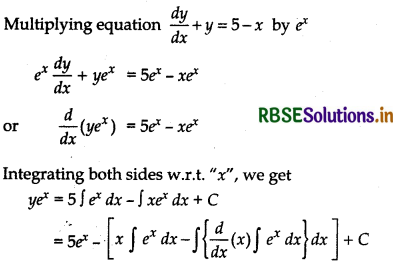
= 5ex - [xex - ∫1 ex dx] + C
= 5ex - xex + ex + C
or yex = 6ex - xex + C
Putting x = 0 and y = 2 in equation (4), we get
2 × e0 = 6e0 - 0 × e0 + C
or 2 = 6 + C
or C = 2 - 6 = - 4
∴ C = - 4
Putting the value of C in equation (4), we get
yex = 6ex - xex - 4
or y = 6 - x - 4e- x
or x + y = 6 - 4e- x
which is the required equation of the curve.

Question 18.
The integrating factor of the differential equation x \(\frac{d y}{d x}\) - y = 2x2 is:
(A) e-x
(B) e-y
(C) \(\frac{1}{x}\)
(D) x
Answer:
Given differential equation
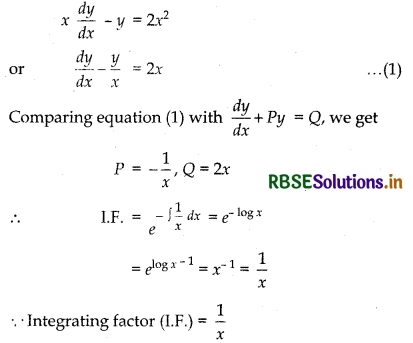
Hence, option (C) is correct
Question 19.
The integrating factor of the differential equation
(1 - y2)\(\frac{d x}{d y}\) + yx = ay {- 1 < y < 1} is:
(A) \(\frac{1}{y^2-1}\)
(B) \(\frac{1}{\sqrt{y^2-1}}\)
(C) \(\frac{1}{1-y^2}\)
(D) \(\frac{1}{\sqrt{1-y^2}}\)
Answer:
Given differential equation is
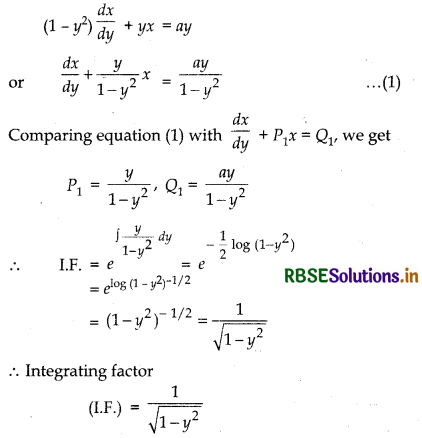
Hence, option (D) is correct.
